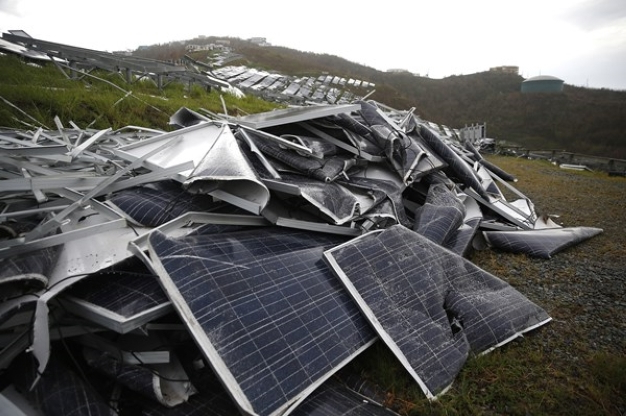Super Therm and Solar Panels – the Perfect Solar Team
Too much heat can be bad for solar panels, reducing their efficiency by 10%-25%, says a US solar supplier. It sounds counterintuitive, but too much heat can reduce the ability of solar to produce power, says the World Economic Forum.
Like an iPhone that switches off when left in the heat, the output of solar panels slows down over 25 degrees by 0.5 percentage points for every degree rise in temperature, it says. Most rooftops in Sydney exceed 50°C on a hot day, said Dr Peter Irga, an atmospheric scientist in the University of Technology Sydney’s Faculty of Engineering. “Solar works better on a rooftop in Scotland or Wales than it does in Sydney,” he said (source).
Hot temperatures can reduce the output efficiency of solar panels by 10%-25%
How does extreme heat affect solar panels?
Heat can “severely reduce” the ability of solar panels to produce power, according to CED Greentech, a solar equipment supplier in the United States. Depending on where they’re installed, hot temperatures can reduce the output efficiency of solar panels by 10%-25%, the company says.
According to the American renewable energy website EnergySage, solar panels are tested at 25°C (77°F) and generally have a temperature range of between 15°C and 35°C. Solar cells – the electronic devices that convert sunlight into electricity that are connected together to build solar panels – produce solar power most efficiently within this range. But solar panels can get as hot as 65°C (149°F), EnergySage says. This can affect the efficiency of solar cells.
Why do solar panels struggle in very hot weather?
The impact of heat on solar panels is to do with the laws of thermodynamics – the science of heat and how it affects things. The electricity generated by solar panels comes from a flow of particles called electrons inside the electrical circuit, explains news site Euronews. When temperatures soar, these electrons can bounce around too much – and this reduces voltage, or the amount of electricity generated (source).
Super Therm and Solar Panels are the perfect team for multiple reasons:
- Both save energy
- Both reduce CO2
- Both work with the sun
- Both bring better value
- Both can protect the building
- Both increases each other’s growth
The cost of investment and return both in dollars but also environmental costs are multi-beneficial. The concept of an energy saving coating is higher value; high performance yet the energy saving returns are there.
In fact Super Therm® and Solar Panels work beautifully with each other for the full encapsulation of solar heat into your home…and converting to electricity.
The increased returns, benefits and longevity of the best performing ceramic solar coating is a solid investment that will last over 20 years. Let’s compare a solar system alone, then combined.
‘Cool roofs’ increase power yield in bifacial rooftop PV systems by 8.6%
An Algerian-Spanish research team has looked at how cool roofs (CR) helps increase power yield in bifacial rooftop PV systems and has found that the proposed combination offers higher energy yields than bifacial counterparts deployed on conventional roofs.
“When a cool roof coating is used beneath the bifacial modules, PV production can be substantially boosted (+8.6%) compared to the monofacial solution, meaning an economic benefit about 18.3 €/kWp/year,” the group said. “Moreover, the [cool roof] coating can help reduce floor temperatures in unshaded areas during summer (−3.8 °C), potentially leading to significant energy savings in cooling the building.”
The scientists said that cool roofs could be either added to the floor of existing bifacial rooftop PV systems or used for new installations. “It is an already available market product with reasonable costs that offers dual advantages: increased energy yield and reduced building cooling consumption, both yielding economic benefits.
Read the article: PV Magazine Australia
Solar Panels with Cool Roofs Review – UNSW – JAN 2022
- The annual energy yield of PV increases by 0.71%-1.36%.
- The cool roof performance increases by 14%.
- The roof surface temperature decreases by 3.1-5.2 °C. A decrease by 1 °C in the roof surface
temperature increases PV system efficiency by 0.2-0.9% (report).
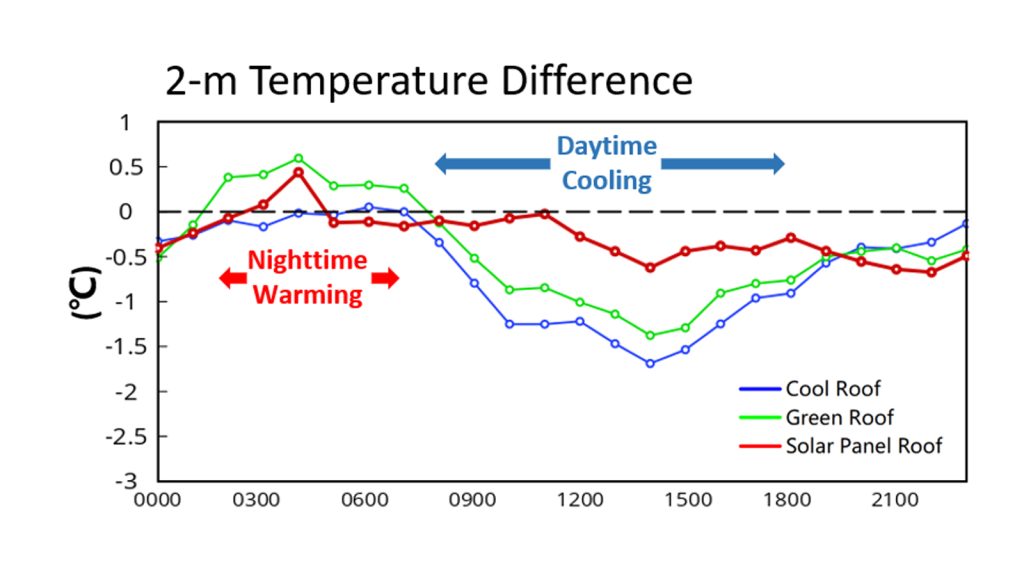
Citywide Impacts of Cool Roof and Rooftop Solar Photovoltaic Deployment on Near-Surface Air Temperature and Cooling Energy Demand – Arizona: Phoenix and Tucson
During the day, cool roofs are more effective at cooling than rooftop solar photovoltaic systems, but during the night, solar panels are more efficient at reducing the UHI effect. For the maximum coverage rate deployment, cool roofs reduced daily citywide cooling energy demand by 13–14%, while rooftop solar photovoltaic panels by 8–11 % (without considering the additional savings derived from their electricity production). The results presented here demonstrate that deployment of both roofing technologies have multiple benefits for the urban environment, while solar photovoltaic panels add additional value because they reduce the dependence on fossil fuel consumption for electricity generation (report).
Cool Roofs Could Be Most Effective at Reducing Outdoor Urban Temperatures in London
On average cool roofs most effectively reduce temperatures (−1.2°C), outperforming green roofs (0°C), solar panels (−0.5°C) and street level vegetation (−0.3°C). Application of air conditioning across London (United Kingdom) increases air temperatures by +0.15°C. Research Paper
An experimental study of the impact of cool roof on solar PV electricity generations on building rooftops in Sharjah, UAE
The preliminary findings of the experimental study indicated that there is a likely impact of 5–10% improvement of electricity generation with the cool roof applications (report).
A 5kW solar system is approximately 30m2
Cost is approximately $5,630 or $187m2 installed + input credits
Super Therm® is $750 for 30m2 or $25m2 + application
Super Therm® is an Energy Saving Coating!
Unique to its formulated compounds, Super Therm®‘s testing will blow you away. As the environment gets hotter this increases demand, political conversation and environmental protection, Cool Roof coatings will be the next big wave of thermal protection for all living spaces and other heat related uses.
Both from the blazing sun, warmer days and nights, UV and blocking 96.1% of the solar heat, ensures you’re protected over 20+ years.
It has been tested by the Department of Energy and it reduces energy consumption between 20-50% (industry tested) so the payback is much quicker and a longer lifespan, showing 32 years of current testing.
*Performance and results are based on industry averages and locations.
Its economic cost versus the environmental impact!
What is the environmental Impact?
The other element of solar is the impact on our environment.
As solar panels last between 10-25 years they will reduce in efficiency over time therefore reduce in savings and end up in landfill. They will expire!
Currently, almost all broken or expired solar panels go into landfill and experts have been warning for some time that more than 100,000 tonnes of modules will end up there by 2035 (ABC). The global outlook for solar panels is bleak based on environmental need. It’s economic cost v environmental impact.
The deployment of low-efficiency, low-cost, and widely available PVSPs (photovoltaic solar panels) may diminish total solar reflectance, raising the risks of PVSPs-based urban heating, particularly during the summertime heatwaves. On the local warming potential of urban rooftop photovoltaic solar panels in cities
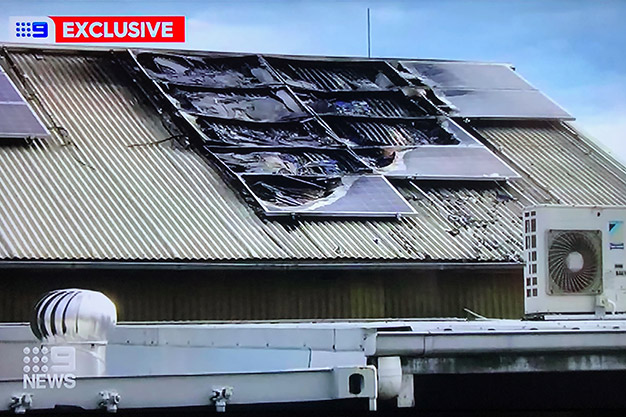
Solar by Area
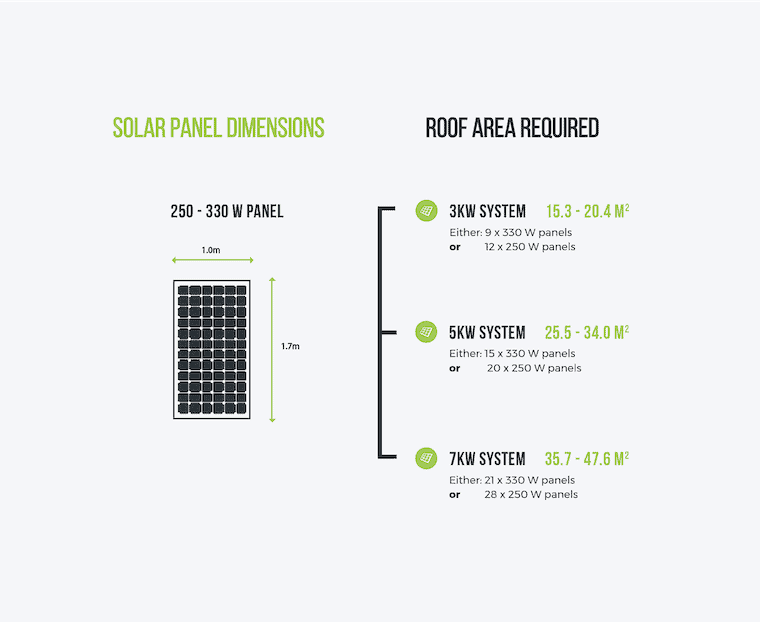
5kW Solar System Prices and Costs
Source: Solar Calculator
The 5kW solar system is the most popular system in Australia with the sheer demand for systems driving down the cost in comparison to smaller system sizes. The cost of a 5kW solar system varies depending on where you reside as there are three major price variables:
- Retail competition in your local market
- The solar rebate applicable to your geographic location
- The quality of the system you wish to install
The table below shows the average price of a 5kW system in major capital cities:5KW SYSTEM PRICES IN MAJOR CITIES:
| Adelaide | $5,638 |
| Brisbane | $5,688 |
| Melbourne | $5,689 |
| Perth | $5,488 |
| Sydney | $5,538 |
The prices above are for the full cost of installation of a 5kW system and include GST, the federal solar rebate and assume the system is comprised of good quality components.
5kW solar inverter cost
The prices shown above include the cost of the inverter for a 5kW system. The quality of the inverter is one of the variants in prices between different systems.
Savings and payback numbers
Both the prices and output of 5kW systems vary according to location and so too do the payback and savings figures. A 5kW system in Melbourne, for example, can payback within six years while in Brisbane it can be less than five years. Below is a snapshot from the Solar Calculator calculator which shows the savings and payback results for a 5kW system in Sydney:
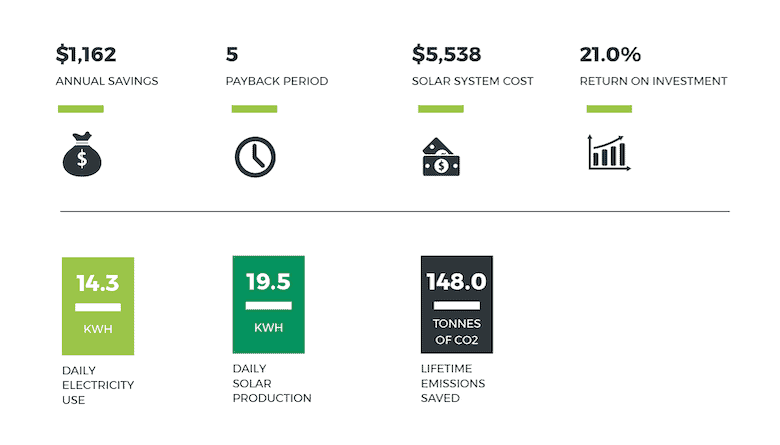
Internal roof space in Australian home
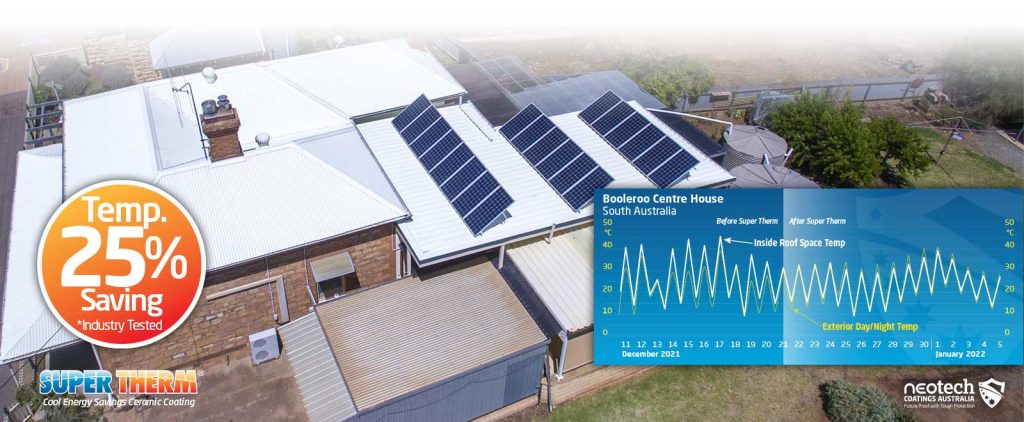
Guide: Original Temperature: 40°C; New Temperature 30°C
ASHRAE Formula: (Original Temp. X Difference / 24 = tons of energy X 12,000 BTU per ton = BTU Savings = 40 X 10 / 24 X 12,000 = 200,000 BTU
Change BTU into KW to find COST SAVINGS per hour / day / week / month / year. (1 BTU = .293 Watt)
200,000 X .293 Watt = 58,600 Watts / 1000 = 58.6 KW/hr in Australia average (34 cents K/W) or $19.92 per hour savings
3 months (December to February – Summer) of net savings of $19.92 = $1,792.80 (per year savings) or 20 years = $35,856
Savings vs payback
Solar Calculator recommend considering lifetime savings of a 5kW solar system in conjunction with the payback period. The payback calculation tends to favour lower cost systems that may pay back faster, but do not necessarily generate greater savings over the long term. A better quality 5kW system will perform better and not deteriorate at the rate of a lower cost system.
Super Therm’s cost savings speak for themselves
Super Therm on the Nissan Factory, Japan
| Initial Cost for Improvement (¥10,000) (A) | Energy Saving Effect (¥10,000/year) (B) | Pay-Back Period (year) Excluding Interest (A/B) |
| Ceramic Insulation Coating: 6,850 | ||
| Bituminous Coating: 5,680 | ||
| Difference: 1,170 | 1,105 | 1.06 |
Return on Investment
Thirteen (13) month payback savings to investment over the difference in cost of applying Bituminous Coating which has no insulation payback. See more >



